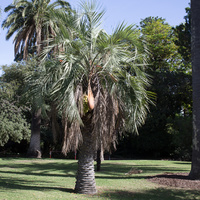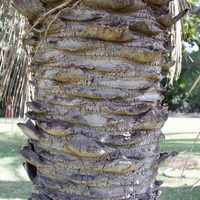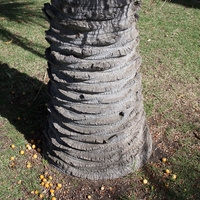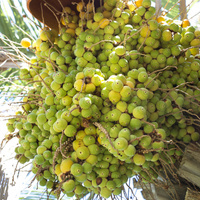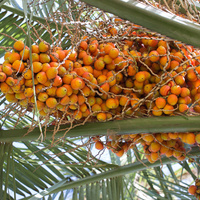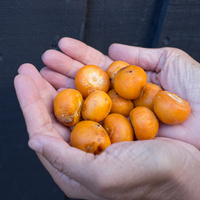Common name: Jelly palm
Other common names: Pindo palm
Description
Jelly palm is a fruiting and landscape palm originating from the Cerrado, a vast savanna-grassland region in Brazil's interior.
It is a slow-growing small palm up to 7 m (23 ft) in height, though it is typically 2 to 5 m (10 to 16 ft) tall with a stout trunk around 30 cm (1 ft) in diameter, roughened by overlapping leaf bases that persist after the old fronds are shed.
The fronds are up to 2.5 m (8.2 ft) long and typically palm-like, with long, tapering blue-grey leaflets arranged in pairs along the length and together form a rounded crown. Sharp spines arm the stalk end.
Flowers are small and insignificant, creamy-white, and bloom from spring to summer in large branched flower spikes at the crown's centre. The fertilised flowers develop into small, green, bowl-shaped fruit, around 2.5 cm (1 in) long, tightly packed on large hanging bunches. When ripe, they are orange with juicy, fibrous pulp surrounding a tough round nut with one to three seed inside.
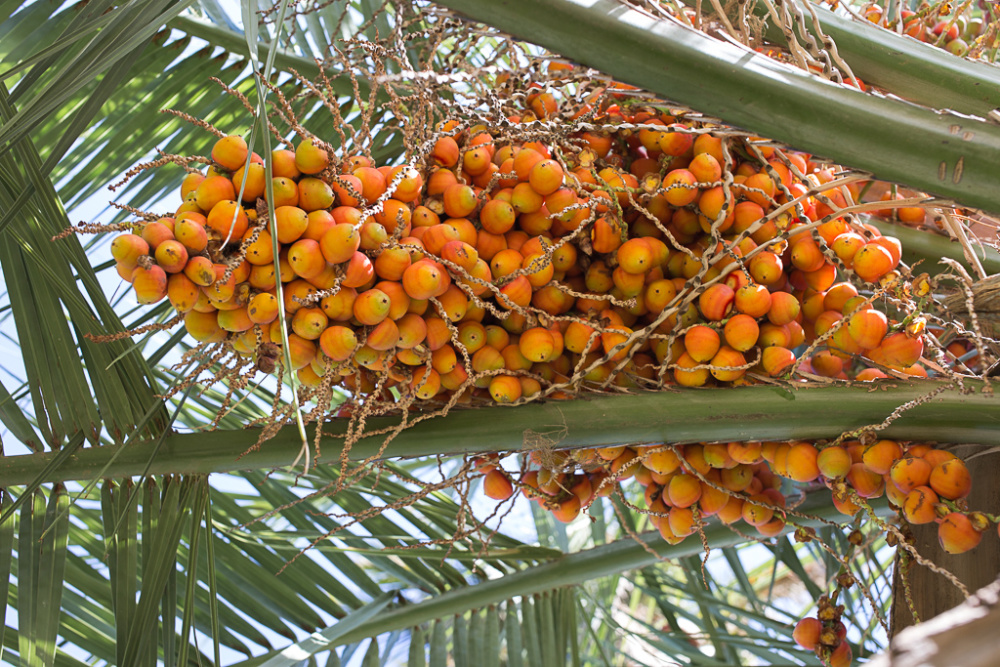
Use
The fruit are edible when fully ripe, with soft orange pulp that easily separates for the seed. Although sometimes eaten fresh, the pulp is fibrous and is mostly pureed or juiced to make jam or jelly or to flavour drinks, ice cream and other desserts. The flavour is mildly sour, reminding of pineapple and mango. They tend to ripen all at once if harvested as a bunch.
The palm's small stature, showy bark and foliage, and tolerance to salt spray make it suitable for home and seaside gardens.
Climate
Jelly palm grows naturally in sub-humid to moderately humid subtropical and tropical lowland to mid-elevation climates, generally areas with annual lows of 9 to 22 °C, annual highs of 19 to 35 °C, annual rainfall of 600 to 1900 mm and a dry season of 7 months or less, extending to 12 months with irrigation or groundwater.
Growing
New plants are usually started from seed, which can take up to eight months to germinate and benefit from pre-soaking in water before sowing.
Performs best on rich, free-draining loam and sand soils of a moderately acid to slightly alkaline nature, generally with a pH of 5.0 to 7.5, and on sites with full to partial sun exposure. It has good tolerance to drought, seasonal flooding, wind and salt spray.
When cultivated as an ornamental, the dead leaves need to be pruned to maintain a neat appearance.
Problem features
It is widely introduced and cultivated in non-native areas and is listed as a weed in at least one reference publication. Still, there does not appear to be any record of it anywhere as a serious weed.
It is assessed as a low weed risk species for Hawaii and south Florida, respectively, by the Hawaii Pacific Weed Risk Assessment (HPWRA) project and the IFAS Assessment of Non-Native Plants in Florida's Natural Areas.
The fruit fall to the ground when ripe and create litter.
Where it grows
References
Books
-
Blombery, A. M. & Rodd, A. N. 1992, An informative, practical guide to palms of the world : their cultivation, care and landscape use, (Revised edition), Angus & Robertson, North Ryde, New South Wales
-
Gilman, E. F. 1997, Trees for urban and suburban landscapes, Delmar Publishers, Albany, New York
-
Henderson, A., Galeano, G. and Bernal, R. 1995, Field guide to the palms of the Americas, Princeton University Press, Princeton, New Jersey
-
Janick, J., & Paull, R. E. 2008, The encyclopedia of fruit & nuts, CABI Publishing, Wallingford, Oxfordshire
-
Lorenzi, H. 2006, Brazilian fruits & cultivated exotics (for consuming in natura), Instituto Plantarum de Estudos da Flora, Nova Odessa, San Paulo
-
Martin, F. M., et al. 1987, Perennial edible fruits of the tropics : an inventory, U.S. Dept. of Agriculture (USDA), Agricultural Research Service, U.S. Government Printing Office (GPO), Washington, D.C.
-
Perry, B. 2010, Landscape plants for California gardens: an illustrated reference of plants for California landscapes, Land Design Publishing, Claremont, California
-
Randall, R. P. 2002, A global compendium of weeds, R.G. and F.J. Richardson Press, Melbourne
-
Randall, R. P. 2007, The introduced flora of Australia and its weed status, Cooperative Research Centre for Australian Weed Management, Glen Osmond, South Australia
